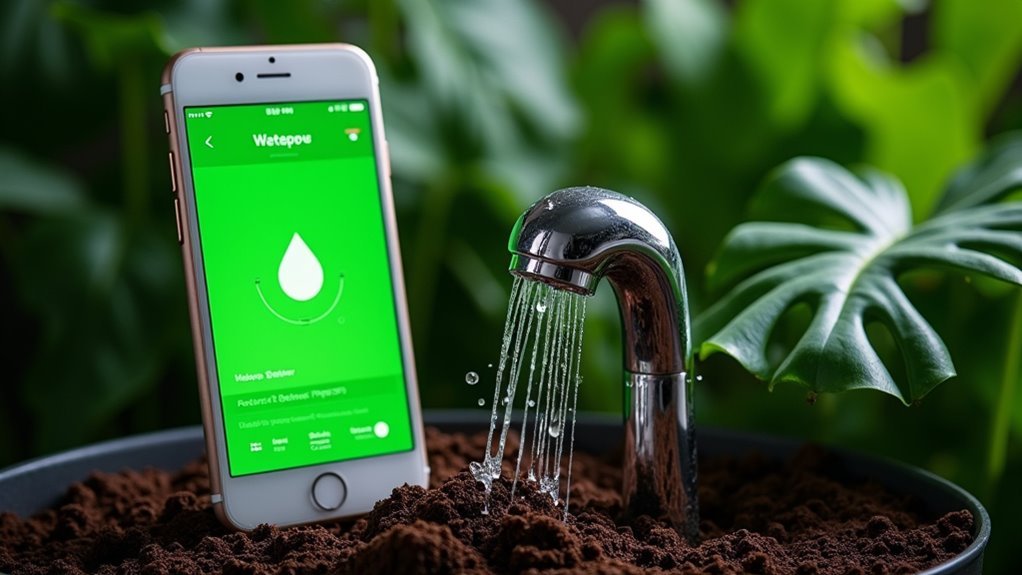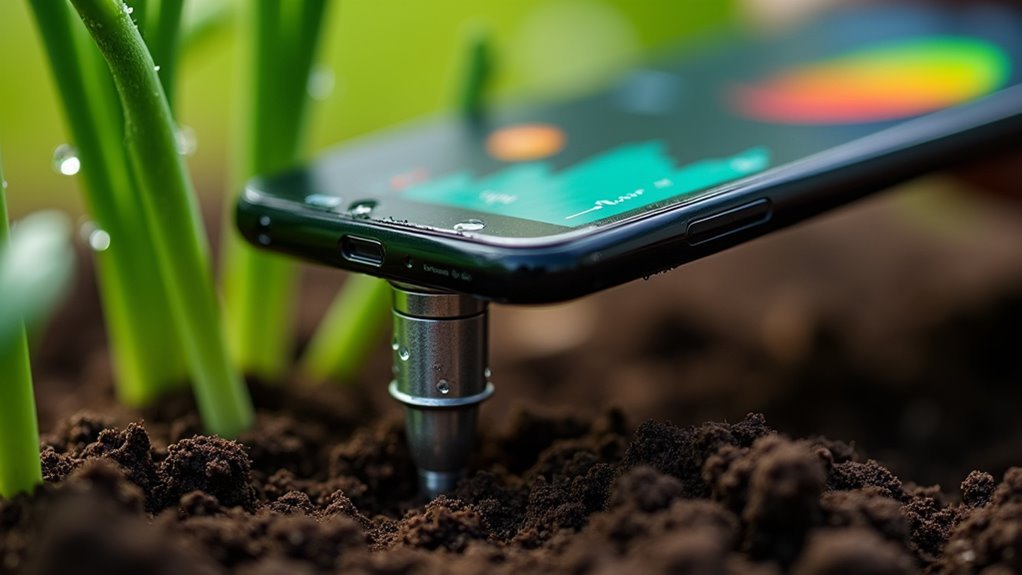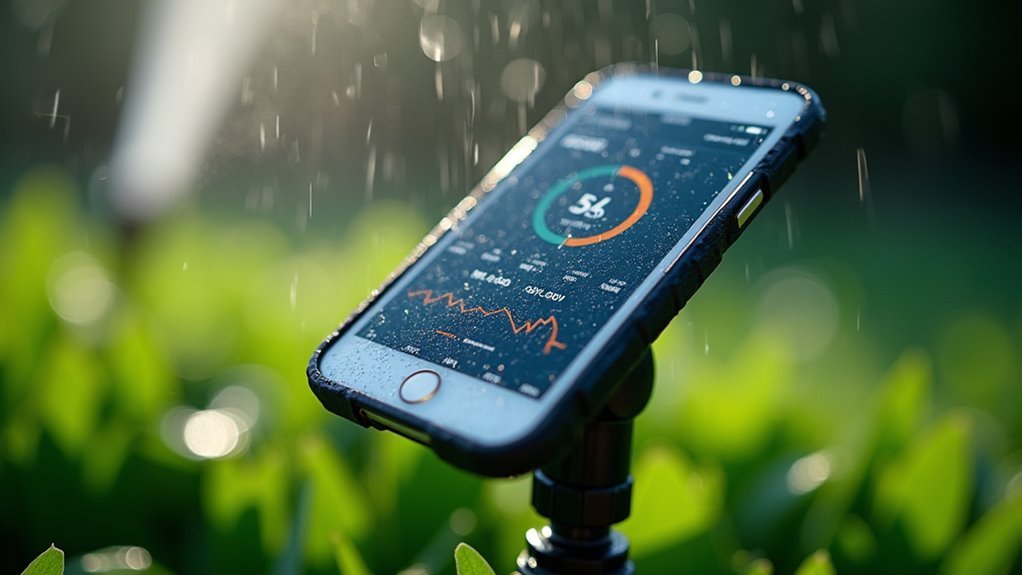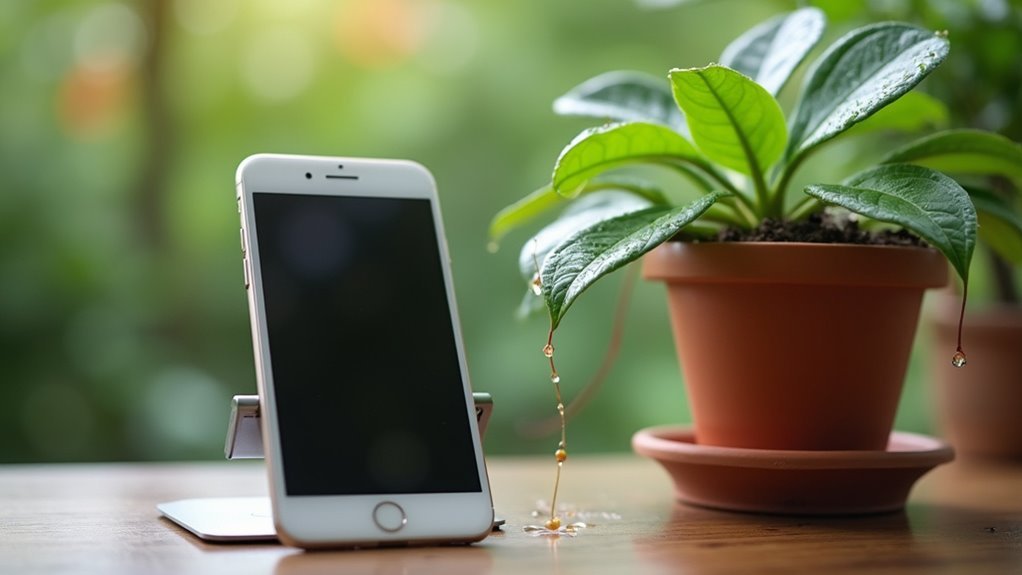You’ve probably wondered what separates a truly smart irrigation system from a basic timer-controlled sprinkler. The answer lies in sophisticated technology that doesn’t just water your plants—it thinks about when, how much, and why they need watering. These systems combine sensors, algorithms, and connectivity to create an intelligent network that responds to real-time conditions. But there’s more happening behind the scenes than you might expect.
Remote Control Through Mobile Applications

When you’re traveling for work or simply can’t tend to your garden daily, smartphone plant watering systems transform how you manage irrigation through intuitive mobile applications.
These smart irrigation systems put complete control at your fingertips, letting you adjust watering schedules and durations from anywhere with an internet connection.
You’ll receive real-time alerts about system performance, ensuring you’re always informed about your plants’ needs. The app notifies you when repairs or adjustments are necessary, preventing potential damage to your garden.
Advanced scheduling features allow you to customize watering for different plant zones, ensuring each area gets precisely what it needs. Whether you’re across town or across the country, you maintain full oversight of your irrigation system’s operation.
Automated Scheduling and Timer Functions
You’ll find programmable timer technology at the heart of smart watering systems, allowing you to set precise schedules that automatically adjust for seasonal changes and optimize water usage year-round.
These advanced timers can incorporate weather-based adjustments, automatically modifying your watering schedule when they detect rainfall, temperature changes, or other environmental factors.
You can also create different schedules for various zones in your garden, ensuring each plant type receives the exact amount of water it needs.
Programmable Timer Technology
Three key features define programmable timer technology in smartphone-controlled watering systems: automated scheduling, seasonal adjustments, and weather integration.
You’ll find that programmable timers let you customize watering schedules for ideal plant health, targeting early morning or late evening hours to minimize evaporation. Your smart irrigation system automatically adjusts with seasonal changes, ensuring plants receive appropriate water amounts year-round.
You can override automated schedules manually when needed, maintaining control over your garden’s care.
Advanced systems incorporate local weather data, preventing overwatering after rainfall and adjusting during heatwaves. This automation reduces water waste considerably, promoting conservation while lowering your monthly water bills through efficient usage that responds to real-time environmental conditions.
Weather-Based Schedule Adjustments
Smart irrigation systems leverage real-time weather data to automatically modify your watering schedules, preventing overwatering after rainfall and increasing irrigation during dry spells.
These systems analyze weather information including temperature, humidity, and precipitation forecasts to optimize when and how much water your plants receive.
Evapotranspiration controllers represent the most advanced weather-based technology, reducing outdoor water consumption by 20% to 43% through precise calculations of plant water needs.
You’ll receive automated alerts when weather conditions require schedule adjustments, ensuring your plants stay healthy without constant monitoring.
Real-Time Soil Moisture Monitoring

You’ll find that real-time soil moisture monitoring transforms your watering approach by using advanced sensors that measure the exact volumetric water content in your soil.
These systems let you set specific moisture level thresholds, so your smartphone-controlled irrigation activates only when your plants actually need water.
This precision technology can reduce your irrigation by an average of 72%, ensuring you’re never guessing about when to water again.
Sensor Technology Explained
When you’re managing a smartphone-controlled plant watering system, soil moisture sensors serve as the foundation that makes automated irrigation possible. These sensors measure soil volumetric water content to determine precisely when your plants need water, ensuring they receive ideal hydration levels.
Your smart controller can be programmed to trigger irrigation when moisture drops below your customized threshold, promoting efficient water usage.
Here’s how proper sensor implementation maximizes effectiveness:
- Strategic placement in representative landscape areas prevents interference from nearby objects
- Automated activation maintains consistent soil moisture without manual intervention
- Water conservation achieves up to 72% irrigation savings during drought conditions
Beyond conservation, soil moisture sensors enhance plant health by preventing over-saturation and reducing disease risk through precise moisture management.
Moisture Level Thresholds
Setting appropriate moisture level thresholds transforms your sensor data into actionable irrigation commands that keep your plants thriving. Your soil moisture sensors work by monitoring volumetric water content and triggering watering systems when levels drop below your predefined threshold. This prevents both over-watering and under-watering, which can cause plant stress or disease.
| Plant Type | Moisture Threshold |
|---|---|
| Succulents | 20-30% |
| Vegetables | 40-60% |
| Flowering Plants | 50-70% |
| Lawn Grass | 30-50% |
You’ll achieve precise irrigation timing that can save up to 34% water during drought conditions. However, proper sensor installation in representative garden areas is essential, as nearby objects can interfere with accuracy. Tailored thresholds optimize resource usage while promoting healthier plants.
Automatic Irrigation Triggers
While traditional timers operate on fixed schedules regardless of actual soil conditions, automatic irrigation triggers respond dynamically to real-time moisture data from your embedded sensors.
These sophisticated systems monitor volumetric water content continuously, activating watering only when levels drop below your predefined threshold.
Your soil moisture sensors eliminate overwatering risks by providing immediate data that adjusts irrigation schedules based on actual plant needs rather than guesswork.
Strategic installation in representative areas guarantees accurate readings without interference from nearby objects.
The benefits you’ll experience include:
- Water Conservation – Studies show 34% water savings during drought conditions
- Irrigation Efficiency – Average 72% reduction in irrigation frequency
- Smart Integration – Enhanced outdoor water consumption control through intelligent technology
This real-time monitoring approach transforms basic watering into precision plant care.
Weather-Based Irrigation Adjustments

Because weather conditions directly impact your plants’ water needs, smartphone-controlled irrigation systems now integrate real-time meteorological data to automatically adjust watering schedules.
These systems analyze weather data including temperature, humidity, wind speed, and rainfall forecasts to prevent overwatering after storms and underwatering during dry periods.
You’ll see impressive water savings with this technology—studies show reductions of 20% to 43% compared to traditional fixed-timer systems.
Your outdoor water consumption can drop by up to 50% through intelligent weather-based adjustments. The system’s smart algorithms tailor watering to current environmental conditions, ensuring your landscape stays healthy while dramatically lowering your monthly water bills.
This automated approach eliminates guesswork and delivers precise irrigation based on actual weather patterns rather than rigid schedules.
Water Conservation and Efficiency Features
You’ll discover that smartphone plant watering systems excel at conserving water through intelligent features that respond to real-time conditions.
These systems use soil moisture detection to prevent unnecessary watering, while automated schedule optimization guarantees your plants get exactly what they need when they need it.
The combination of weather data integration and smart sensors can slash your water usage by up to 72% during drought conditions.
Real-Time Weather Adjustments
When your smartphone-based watering system connects to real-time weather data, it transforms from a simple timer into an intelligent irrigation manager that adapts to Mother Nature’s ever-changing conditions.
These smart watering systems automatically prevent overwatering after rainfall while ensuring your plants receive adequate moisture during dry spells.
Your system’s weather-based adjustments deliver substantial benefits:
- Evapotranspiration calculations reduce outdoor water usage by 20-43% based on local temperature, humidity, and wind conditions.
- Automated scheduling modifications can achieve up to 50% water savings compared to traditional fixed-timer systems.
- Instant alerts notify you when changing weather patterns require irrigation adjustments.
Soil Moisture Detection
While weather data provides valuable external conditions, soil moisture sensors offer direct insight into what’s actually happening beneath the surface where your plants’ roots live.
Your smartphone system’s soil moisture sensor reads volumetric water content and triggers irrigation only when levels drop below your set threshold. This precision delivers impressive results—you’ll see average irrigation reductions of 72% and water conservation savings of 34% during droughts.
Proper sensor placement in representative soil areas guarantees accurate readings without interference. By automating watering based on real-time moisture data, you’ll eliminate overwatering while promoting healthier root development.
The system tailors irrigation schedules to each plant’s specific needs, optimizing resource use and minimizing waste for maximum water conservation efficiency.
Automated Schedule Optimization
Building on real-time moisture detection, automated schedule enhancement takes your smartphone watering system’s efficiency to the next level by intelligently timing irrigation cycles.
Your irrigation controller utilizes programmable timers for automated scheduling during ideal periods—early morning or late evening—minimizing evaporation losses and maximizing water conservation.
Smart systems integrate weather data to automatically adjust schedules based on:
- Rainfall predictions – Preventing unnecessary watering when rain is forecasted
- Temperature fluctuations – Increasing frequency during heatwaves while reducing irrigation during cooler periods
- Humidity levels – Enhancing water delivery based on atmospheric moisture conditions
This intelligent automated scheduling approach delivers impressive results: outdoor water consumption drops 20-43% on average, while drought conditions can yield savings up to 72%, translating to approximately $33.95 saved per interrupted cycle.
Customizable Watering Zones and Preferences
Since different plants have varying water requirements based on their species, location, and environmental conditions, smartphone plant watering systems excel at creating customizable watering zones that cater to each area’s specific needs.
Your smart irrigation system divides your garden into distinct zones based on plant types, soil conditions, and sunlight exposure, ensuring each receives appropriate hydration.
You can adjust watering schedules for different zones through your smartphone app, setting unique frequencies and durations for each area. This flexibility accommodates seasonal changes and plant maturity stages.
Your system monitors local weather conditions and automatically skips scheduled watering when rainfall occurs, preventing overwatering.
These customizable watering zones promote healthier plant growth while conserving water resources by delivering precise irrigation where and when it’s needed most.
Sensor Integration and Data Collection
You’ll find that modern smartphone plant watering systems rely on sophisticated sensor networks to gather critical environmental data for ideal irrigation decisions.
Your system’s soil moisture sensors measure volumetric water content while weather data integration pulls local temperature, humidity, and rainfall information to create all-encompassing watering schedules.
This real-time environmental monitoring capability sends instant alerts to your phone and analyzes evapotranspiration rates to determine exactly when and how much water your plants need.
Soil Moisture Detection
Advanced soil moisture sensors transform your smartphone watering system into a precision irrigation tool by continuously measuring volumetric water content and triggering automated watering when levels drop below your customized thresholds.
Your soil moisture sensor works by collecting real-time data on current soil conditions, enabling immediate adjustments to irrigation schedules. This technology greatly reduces water consumption while maintaining ideal plant hydration.
To maximize effectiveness, follow these installation guidelines:
- Position sensors in representative garden areas – Place them where they’ll accurately reflect overall soil conditions without interference from nearby objects.
- Configure custom moisture thresholds – Set specific activation points based on your plants’ unique watering requirements.
- Monitor performance data – Track irrigation savings, which average 72% during drought conditions, and overall water savings of 34%.
This integration prevents overwatering while ensuring your plants receive precisely what they need.
Weather Data Integration
When your smartphone watering system integrates real-time weather data, it automatically adjusts irrigation schedules based on rainfall, temperature, humidity, and wind speed to prevent unnecessary watering during natural precipitation events.
Weather forecasts help your system plan ahead, skipping irrigation when rain’s expected within 24-48 hours. This intelligent coordination prevents over-watering and guarantees your plants receive ideal hydration without waste.
Your system’s sensors continuously monitor local meteorological conditions, making split-second decisions that reduce water waste by 20% to 43%.
During rainy periods, automatic shut-offs protect your plants from waterlogging while cutting utility costs. The technology promotes sustainability by conserving precious water resources and minimizing environmental impact.
You’ll notice healthier plants and lower water bills as your system learns local weather patterns and adapts accordingly.
Real-Time Environmental Monitoring
Precision drives modern smartphone watering systems through sophisticated sensor networks that continuously measure your garden’s environmental conditions.
These real-time monitoring capabilities transform how you manage plant hydration by collecting data from multiple environmental factors simultaneously.
Your smart watering system processes three critical data streams:
- Soil moisture sensors – Track actual water content in root zones for precise irrigation timing
- Temperature and humidity monitors – Measure atmospheric conditions affecting plant water absorption
- Weather conditions integration – Combine local forecasts with sensor data for ideal scheduling
Advanced sensor integration sends instant alerts to your smartphone when irregularities occur, such as moisture deficiencies or system leaks.
Push Notifications and Alert Systems
Although traditional plant care relies on visual inspection and guesswork, smartphone-connected watering systems transform plant monitoring through intelligent push notifications that keep you informed about your garden’s needs in real-time.
These alert systems deliver essential information directly to your device, notifying you about current soil moisture levels and precisely when irrigation’s required.
You’ll receive environmental alerts covering rainfall and temperature changes, preventing both overwatering and underwatering scenarios.
The system sends maintenance notifications when malfunctions occur, enabling quick responses that protect your plants’ health.
Additionally, you’ll get updates about scheduled watering times and automatic adjustments based on live data.
Manual intervention reminders help maintain peak performance by prompting you to check for leaks or clean sensors, ensuring your watering system operates efficiently.
Plant Health Monitoring Capabilities
Beyond basic watering alerts, smartphone plant monitoring systems provide thorough health tracking that transforms how you understand your garden’s biological needs.
These sophisticated systems continuously analyze multiple environmental factors to guarantee peak plant health while delivering precisely the water it needs.
Your smart monitoring system tracks three critical metrics:
- Soil moisture levels – Volumetric water content sensors provide real-time data about actual soil conditions.
- Evapotranspiration rates – Advanced algorithms calculate exactly how much water plants lose through natural processes.
- Environmental conditions – Weather data integration prevents over-irrigation during rainfall and adjusts for temperature changes.
You’ll receive detailed plant health insights through your smartphone app, including growth patterns, stress indicators, and customized care recommendations for different plant varieties, guaranteeing each receives targeted attention.
Smart Home Ecosystem Compatibility
Through seamless integration with your existing smart home ecosystem, smartphone plant watering systems become powerful hubs that coordinate multiple devices for thorough garden management. You can control everything through a single app, connecting smart watering systems with soil moisture sensors, weather stations, and irrigation controllers like the Shelly Pro 1.
| Smart Home Integration Features | Benefits |
|---|---|
| Weather Data Connectivity | Automatic schedule adjustments based on real-time conditions |
| Home Assistant Compatibility | Custom automation and personalized preferences |
| Multi-Device Coordination | Centralized control of all garden smart home devices |
You’ll receive proactive alerts about system performance, watering schedules, and maintenance needs. This compatibility optimizes water usage while making precise watering decisions that promote healthier plant growth through coordinated environmental monitoring.
Precision Watering Based on Plant Needs
When smartphone plant watering systems leverage soil moisture sensors and real-time environmental data, they deliver precision irrigation that matches each plant’s specific hydration requirements.
You’ll benefit from smart watering technology that analyzes your garden’s unique conditions rather than following rigid schedules.
These systems revolutionize how you meet your plants’ water needs through:
- Dynamic scheduling adjustments – Your system responds to weather patterns, preventing overwatering during rain and increasing irrigation during heatwaves.
- Evapotranspiration optimization – ET data helps achieve 20-43% water savings compared to traditional timers.
- Plant-specific customization – You can tailor watering duration and frequency for different species, promoting healthier growth and stronger root development.
Automated alerts keep you informed about soil moisture levels, enabling timely interventions that enhance plant health while minimizing water waste.
Water Usage Tracking and Analytics
Detailed water usage tracking transforms your smartphone plant watering system into a powerful conservation tool that monitors every drop applied to your garden.
You’ll access historical data showing consumption patterns over weeks and months, helping you identify wasteful habits and optimize irrigation schedules. Real-time feedback displays your water usage efficiency, letting you adjust watering frequency to reduce costs while maintaining plant health.
Historical data reveals consumption patterns while real-time feedback helps you optimize watering schedules and reduce costs effectively.
Advanced analytics integrate local weather data, showing how rainfall and temperature affect your watering needs. You’ll see exactly when natural precipitation reduces irrigation requirements.
The system automatically alerts you about excessive water usage, preventing waste before it becomes problematic. This extensive tracking empowers you to make data-driven decisions that conserve water resources and improve your garden’s overall sustainability.
Emergency Override and Safety Features
Although smartphone plant watering systems excel at automation, unexpected situations demand immediate human intervention through robust emergency override capabilities.
You’ll have instant remote control through your smartphone app, allowing you to respond quickly to weather changes or system malfunctions.
These safety mechanisms protect your plants and property:
- Normally closed solenoid valves prevent flooding by only allowing water flow when powered
- Leak detection sensors trigger immediate alerts for quick problem identification and resolution
- Weather integration features automatically shut off the system during heavy rainfall or freezing temperatures
You’ll also receive regular maintenance prompts reminding you to clean filters and sensors.
This thorough approach guarantees your smart watering system operates safely while maintaining ideal plant care through both automated functions and manual oversight.
Machine Learning and Adaptive Algorithms
While emergency overrides provide essential manual control, machine learning algorithms elevate your smartphone watering system to an entirely new level of intelligence. These adaptive algorithms analyze historical weather data and current environmental conditions to enhance your irrigation schedules, achieving water savings up to 50%.
| Learning Capability | Function | Benefit |
|---|---|---|
| Historical Analysis | Reviews past weather patterns | Predicts ideal watering times |
| Real-time Adjustment | Responds to soil moisture data | Delivers precise water amounts |
| Seasonal Adaptation | Anticipates growth stage needs | Maintains plant health year-round |
Your system continuously learns from past watering patterns, improving efficiency while reducing unnecessary consumption. As climate conditions change, these adaptive algorithms adjust automatically, ensuring your plants receive exactly what they need when they need it.
Frequently Asked Questions
How Does a Smart Watering System Work?
Your smart watering system uses sensors to monitor soil moisture and weather conditions, then automatically adjusts watering schedules through a smart controller. You’ll receive smartphone alerts and can remotely control the system.
What Is the Motivation for Smart Irrigation System?
You’re motivated to install smart irrigation systems because you’ll reduce water waste that accounts for 30-50% of household consumption, save money with quick payback periods, and maintain healthier landscapes.
What Is the Benefit of a Smart Irrigation Controller?
You’ll reduce outdoor water use by 20-43% while eliminating watering guesswork. Smart controllers automatically adjust schedules based on weather and soil moisture, lowering your bills and ensuring plants get ideal water amounts.
What Is the Purpose of Smart Irrigation System?
You’ll automate and optimize your watering schedules using real-time environmental data. Smart irrigation systems help you reduce water waste, prevent over-watering, and guarantee your plants receive precisely the right amount of water when needed.





Leave a Reply